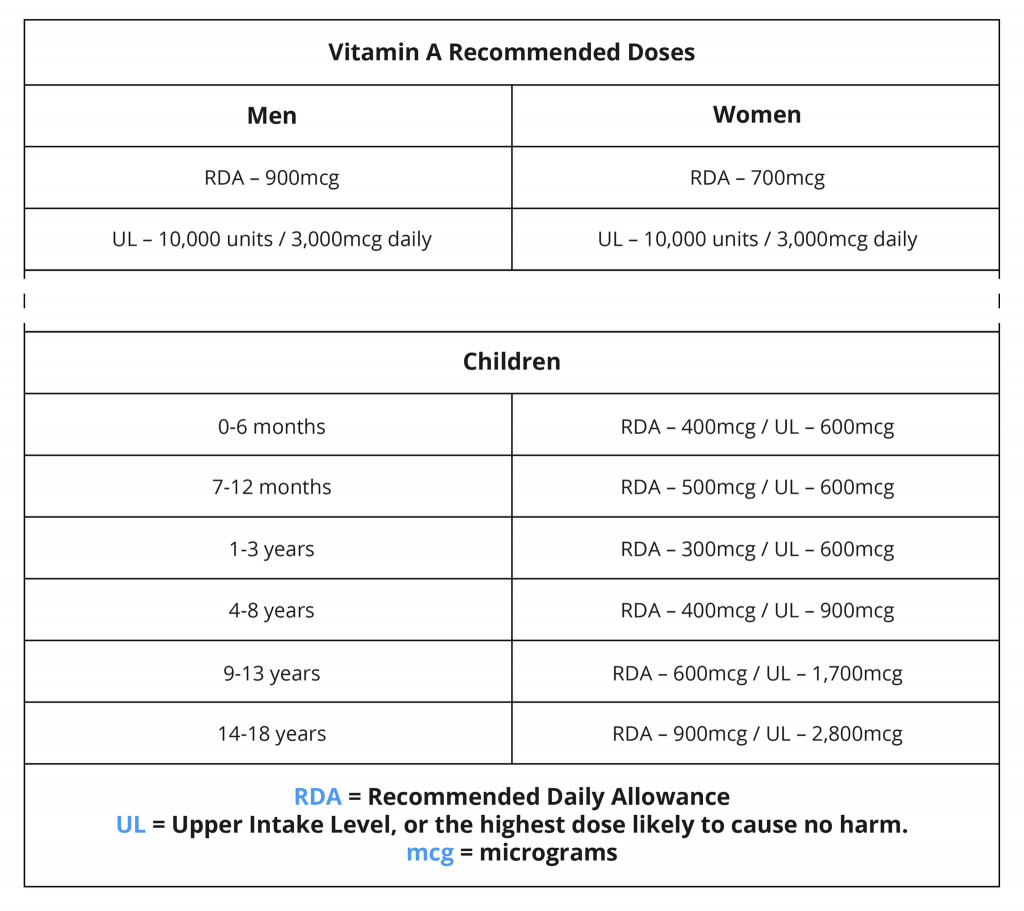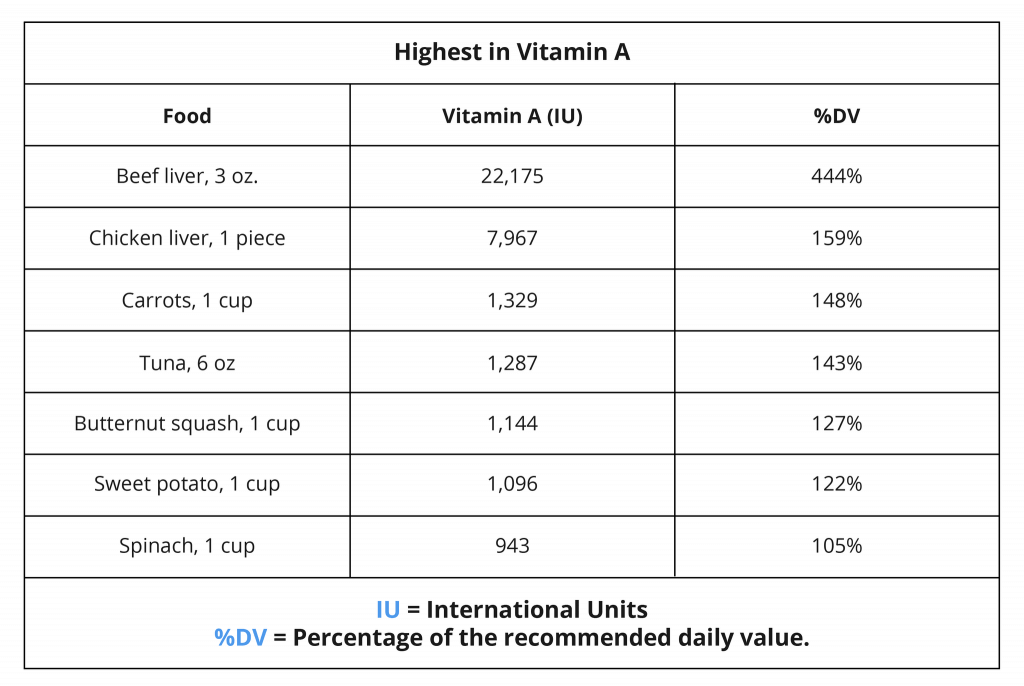- What is vitamin A?
- What is beta-carotene?
- How vitamin A and beta-carotene benefit the body
- What happens if I don’t get enough vitamin A?
- Common symptoms of vitamin A deficiency:
- How much vitamin A do I need?
- How to get more vitamin A in your diet
- There is another way to A.
- Too much of a good thing: a word about vitamin a toxicity
- Conclusion
- Source
You have probably been told many times how vitamin A and its companion substance beta-carotene are essential nutrients for eye health.
What is not always as clear is how they work. What are these oft-touted nutritional components, and what do they do in the body? Consider this your primer on vitamin A, beta-carotene, and their roles in building robust bodies and better vision.
What is vitamin A?
Vitamin A, the “eye vitamin,” is fat-soluble, meaning it is absorbed in the digestive system’s fats before entering the rest of the body. Dietary fats help the body digest this vitamin and eventually store it in body tissues, where it contributes to a robust immune system, skin and bone growth, and of course, a healthy eye.
While vitamin A can be manufactured or made water-soluble, most nutritionists advise people to get vitamin A from their diet. We will discuss the best ways to achieve this later in the article.
It is helpful to realize there are two types of vitamin A:
- Retinol, or preformed vitamin A. While most of us associated carrots with vitamin A, that is not quite true. The vitamin A that is absorbed directly into your body is derived from animal sources, such as liver, fatty fish, milk, and cheese.
- Carotenoids, also known as provitamin A. This is an indirect way of getting vitamin A into your body by ingesting nutrients your body then synthesized into vitamin A. Beta-carotene is the best-known and most effective carotenoid source.
What is beta-carotene?
A discussion about vitamin A would not be complete without addressing beta-carotene. Beta-carotene is a yellow, orange, or red pigment that gives plant-based foods such as carrots, sweet potatoes, and red peppers their bright hues. The name comes from the Latin words “beta” and “carota” for carrot.
Beta-carotene is not itself a vitamin but a “provitamin A carotenoid,” which means it is converted to vitamin A in the body. It is also a powerful antioxidant vitamin aid, serving to prevent oxidative damage in the body (it is especially effective combined with vitamin E).
Because beta-carotene is converted to vitamin A, much of this information will focus on vitamin A benefits, side-effects, sources, and advice.
How vitamin A and beta-carotene benefit the body
Oxidative damage in the eyes increases the risk of glaucoma, cataract formation, and age-related macular degeneration, among other vision issues.
Some of this damage occurs as a natural consequence of the aging process; however, poor diet and the diseases that develop can make us more vulnerable to these effects or exacerbate them.
Vitamin A and beta-carotene offer powerful antioxidant benefits, thereby reducing these risks. That could mean sharper vision for longer as the body fends off the natural progression of age and its effects on the eyes.
Vitamin A also benefits the eyes by feeding healthier mucus membranes, the cornea (the surface of the eye). When healthy and strong, these natural barriers help our bodies block viruses and bacteria that could lead to infections. A slew of scientific research seems to back up the age-old wisdom of eating carrots for better eyesight:
Recently the National Eye Institute sponsored a wide-ranging Age-Related Eye Disease Study (AREDS) to research the effect of a formula of vitamins A, C, and E, beta-carotene, copper, and zinc would have on disease progression. Over the course of the six-year study, researchers noted a 25 percent reduction in the risk for advanced age-related macular degeneration, or AMD, in individuals with a mild form of the disease.
According to a similar study by Harvard Medical School and cooperating universities, vitamin A and lutein may also promise to delay the progression of retinitis pigmentosa. Researchers observed patients with RP who supplemented with vitamin A and lutein for four years, noting a slower loss of peripheral vision in subjects who took the supplements than those who did not.
Juvenile macular degeneration sufferers may also get a positive bump from boning up on vitamin A. Columbia University Medical Center researchers studied whether a synthetic form of vitamin A could also slow the disease process. Mice with the same genetic defect were fed a modified version of vitamin A, which was found to inhibit the formation of growths associated with vision loss in the disease.
What happens if I don’t get enough vitamin A?
In the United States, where most individuals have ready access to nutritious food, vitamin A deficiency is uncommon. However, it is not unheard of in poorer developing countries.
In fact, by some estimates, up to half a million children around the world lose eyesight due to malnutrition, namely vitamin A deficiency. Aside from an inadequate diet, a vitamin A deficiency could also result from digestive or liver disorders that cause malabsorption of nutrients.
Inadequate vitamin A leads to a drying out of the cornea, which leads to corneal ulcers, clouding of the eye, retinal damage (such as diabetic retinopathy), and, ultimately, to blindness. Vitamin A deficiency is easily treatable, so look for common symptoms and consider other possible symptoms if you:
a.) live in a “food desert” where nutritious food is available
b.) have a pre-existing condition that puts you at risk of deficiency, such as liver or thyroid disorders
c.) you eat a generally unhealthy diet that doesn’t include many vegetables, plant-based foods, or vitamin A-rich meats like beef or chicken liver.
Common symptoms of vitamin A deficiency:
- Dry skin and rashes. Vitamin A is vital in maintaining healthy vision and skin. When we don’t get enough of it, skin dryness and irritation can develop.
- Dry eyes. Lack of vitamin A is especially hard on the eyes, which rely on the vitamin to build and maintain healthy corneas and other eye structures. One of the first tip-offs to vitamin A deficiency is an inability to produce tears or adequate tears. This can spin off into blurry vision, eye irritation, and the presence of bothersome “gunk” in the eyes.
- Night blindness or poor night adaptability. Another of the most common early symptoms of vitamin A deficiency is night blindness. This and dry eye are rampant in developing nations where there is inadequate access to good nutrition.
Possible symptoms of deficiency:
- Frequent infections. Because vitamin A is essential for a fully functional immune system, throat and upper respiratory infections may indicate a deficiency.
- Poor wound healing. Low vitamin A may contribute to an inability to adequately heal from wounds, particularly to the skin, which relies on the vitamin for a robust immune response.
- Acne. Studies have shown a link between vitamin A levels and acne lesions in adults. Both oral treatment (such as Accutane) and topical vitamin A significantly reduce the frequency and severity of acne lesions.
- Inability to conceive. Though harder to pinpoint, a lack of fertility can also result from insufficient vitamin A (though vitamin D or B12 anemia and thyroid issues may also play significant roles).
How much vitamin A do I need?
Most people can easily get all the vitamin A their body requires – or any vitamin or mineral for that matter – from a healthy diet that incorporates a variety of plant- and animal-based foods. And to be honest, most nutrition and medical experts would prefer that their patients meet nutritional needs this way – naturally.
Further down in this article, we will offer ideas about the best natural sources of vitamin A. First, though, let’s go over how much vitamin A your body needs to function at its best. The National Institutes of Health’s Office of Dietary Supplements provides a wealth of daily nutritional recommendations for every demographic. Use these recommendations as a starting point for fine-tuning your diet for overall eye health.

NOTE: Vitamin A appears to have the greatest impact on eye health and overall well-being when combined with other vitamins and antioxidants. Specifically, the research studies mentioned above looked at the effect of vitamin A and other supplements on the reduced risk of macular degeneration. A well-balanced diet will ensure adequate amounts of these vitamins, nutrients, and antioxidants.
How to get more vitamin A in your diet
The USDA National Nutrient Database for Standard Reference provides a wealth of nutritional data for hundreds of common foods in raw and cooked forms.

Like spinach, other leafy green vegetables are excellent sources of vitamin A. These greens offer the best nutritional punch when cooked with a small amount of oil or butter to carry the fat-soluble vitamin more effectively to the body:
- bok choy
- collard greens
- mustard greens
- kale
- Swiss chard
Other sources of vitamin A can be consumed raw:
- bell peppers
- lettuce
- citrus fruits (oranges, lemons, limes, grapefruits, pomelos)
- broccoli
- cantaloupe
- bilberry
While it is easy to get an adequate amount of eye-healthy vitamin A, you can use nutritional supplements to close nutrition gaps. Consider fish oil or zinc supplements or a multivitamin with vitamin A, vitamin C, vitamin E, vitamin D, lutein, DHA.
A good rule of thumb to follow to eat for eye health is to fill your grocery cart or plate with plenty of vivid colors. At mealtime, reserve at least half of your plate for the brightest hues: greens, oranges, reds, and yellows. Save room for a 3- to 6-oz. portion of beef liver, chicken liver, or another lean meat.
There is another way to A.
Vitamin A not only protects from the inside out; it also provides benefits when applied directly to the body surface. Among its most popular uses is retinoid and retinol creams for the face and body, which are used to treat acne and reduce wrinkles’ appearance. Vitamin A skin products work by stimulating the production of the protein collagen to firm up the skin.
When it comes to topical application of vitamin A to the eyes, the news is even better. Vitamin A has been an ingredient in over-the-counter lubricating eye drops for some time now, to great effect.
These drops are readily available in most stores and, in many instances, are just as effective as prescription drops formulated for the treatment of dry eye syndrome (with the bonus benefit of costing quite a bit less than OTC products). Physicians also use eye drops containing vitamin A to treat superior limbic keratoconjunctivitis, an inflammation of the area between the cornea and sclera.
Too much of a good thing: a word about vitamin a toxicity
Hypervitaminosis. It sounds like a word you would hear sung by a beguiling nanny. Unfortunately, hypervitaminosis does not have such frivolous or happy connotations.
Hypervitaminosis A, specifically, is the condition of having too much vitamin A in your body – in other words, vitamin A toxicity. There are two types of vitamin A toxicity:
Acute hypervitaminosis. This version of hypervitaminosis A is the result of ingesting more vitamin A than your body can handle in a short period of time. Most vitamin A toxicity cases occur with the overuse of dietary supplements or the use of high-dose supplements. Overdosing on vitamin A within the span of a day or week accumulates in the body, where it is stored in the liver.
Sometimes, however, the body gets too much fat-soluble vitamin A from animal-based foods. The body cannot easily excrete excessive fat-soluble vitamin A, so it is stored in body fat; continuous excess of vitamin A can build up within the body to toxic levels.
It is worth noting that beta-carotene very rarely causes vitamin A toxicity like vitamin A in animal-based foods can. Beta-carotene and another provitamin A carotenoids are water-soluble, and thus, are readily excreted.
Although it is uncommon, vitamin A toxicity can also occur from a topical treatment. Prolonged administration of high-dose vitamin A skin creams can cause hypervitaminosis A in some people. A component called isotretinoin – found in medications such as Sotret and Absorica, for example – are likely culprits in this rare condition.
Chronic hypervitaminosis. Ongoing use or ingestion of high doses of vitamin A can cause chronic vitamin A toxicity. By consistently consuming excessive amounts of vitamin A – usually from dietary supplements – the steady buildup of the vitamin in your body will eventually reach toxic levels over a long time.
A daily vitamin A dose of 25,000 IU is enough to bring on chronic toxicity; the threshold is much lower for children sensitive to vitamin A. Remember the upper intake level (UI) for vitamin A we covered earlier? These nutritional recommendations are ideal for ensuring good health and vitality. More than that – particularly without a doctor’s prescription – will not benefit most people.
WARNING: Vitamin A toxicity is serious! Left untreated or allowed to continue, hypervitaminosis A can cause increased brain pressure and liver damage.
How will I know if I took too much vitamin A?
More is not necessarily better when it comes to a nutritional supplement, and too much of anything (even seemingly innocuous water) can have serious repercussions. If you suspect vitamin A toxicity, check the following symptom assessment to determine whether you might be at risk for hypervitaminosis A:
- My daily nutrition routine includes megavitamins with vitamin A.
- Sometimes I take more vitamins than are recommended by nutritionists and doctors.
- I am a longtime user of prescription topical acne medications.
- I have experienced visual disturbances.
- I am noticing skin changes, rashes, and/or skin peeling.
- I have experienced bone pain.
- My head hurts.
- I have had bouts of dizziness and drowsiness.
- I have lost my appetite.
- My tummy is queasy/I have vomited recently for unknown reasons.
If you checked four or more boxes in this assessment, contact your doctor. (S)he can administer a blood test to determine if your vitamin A has reached a toxic level. Hypervitaminosis A can usually be treated easily by reducing the intake of vitamin A.
Get Your FREE Eye Health Diet Plan
- Nine most important vitamins for eye health
- How to naturally protect and improve your eye health as you age
- Developed exclusively by our medical doctor
Conclusion
As with most things having to do with the body, a well-balanced variety of vegetables, fruits, legumes, and lean proteins usually provides us with everything we need to fuel our bodies and maintain robust health. The benefits of beta-carotene and vitamin a for eyes is no exception to the rule.
Interested in reaping the best eye benefits from vitamin A? Start with a baseline eye exam. Your eye doctor can determine whether you need supplementation, topical treatment, or the status quo for optimal vision and eye health.






